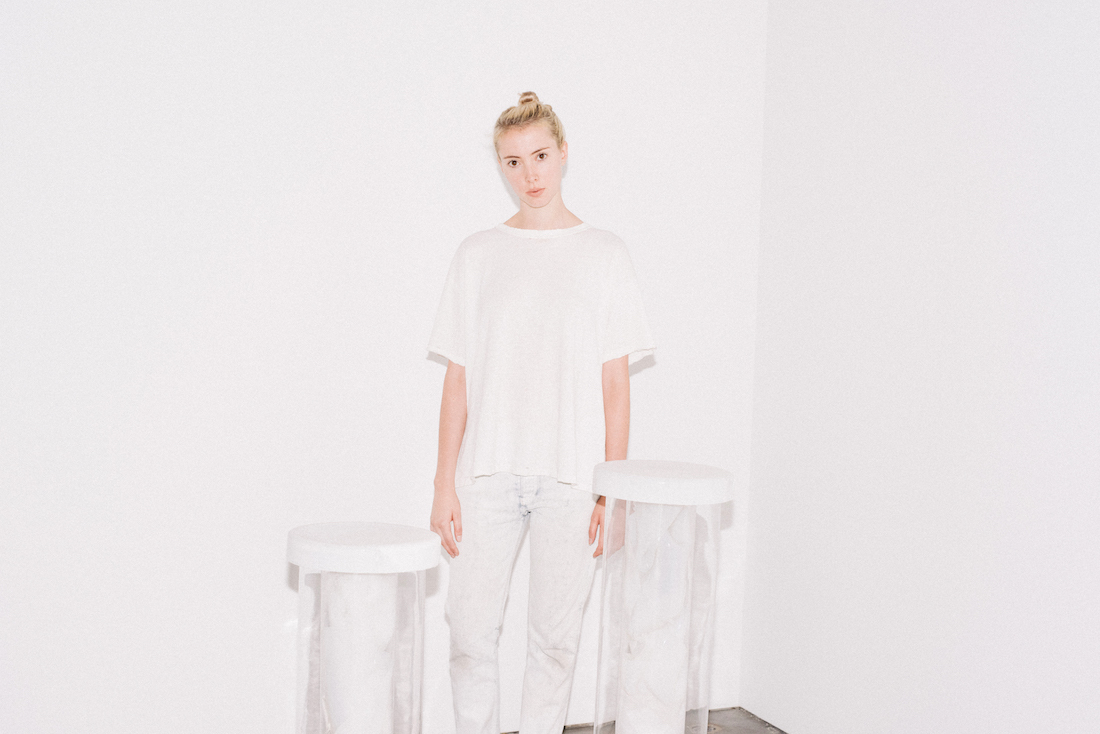Hayden Dunham signs off her emails with a pale-blue sneaker emoji surrounded by two clouds. I don’t know why but it seems like a perfect symbol for her universe. Hayden is an artist who focuses on coaxing meaning from tangible, readily available materials in her studio practice. But she’s intriguingly hard to pin down in the real world (the one in which she is 27, studied at the Gallatin School and lives in downtown New York). Perhaps it’s because she embodies multiple identities in her art – most famously, plasticky PC Music pop project QT. But either way, a solid, everyday sneaker disappearing between two little white puffs of cloud seems just right.
Hayden doesn’t talk about QT in interviews. But, more interestingly, what she did want to talk about, over Gchat last week, are her recent adventures in chemical engineering – the results of which went on display at a three-artist show at Andrea Rosen in New York earlier this month. The exhibition, EVERYTHINGS, showed Dunham’s work alongside pieces by other young artists Parker Ito and Timur Si-Qin. It was a trippy triptych of installations that explored the communicative powers of objects. It was puzzling (in a good way) and left you pondering the meaning of it all long after you left.
And whether you knew it or not, Dunham’s work was also literally still in your system when you walked out the door. Her key material, and the title of all eight of her pieces, was “GEL,” a chemical supplement she created in her New York studio-cum-laboratory. In the show it took the form of a liquid, filling three water dispensers on the wall, a solid (infused into mixed media sculptures and subtle silk canvases) and a vapor, which was pumped through the gallery’s air vents. You were consuming and becoming part of Hayden’s work simply by virtue of being in the space and breathing.
While developing GEL (made up of a blend of existing commercial products that relate to energy), Hayden became interested in the chemical company DuPont — responsible for creating household-name compounds like neoprene, rayon and Teflon. In particular, she was fascinated by a chemical ingredient named C8. “When they first created Teflon in 1946, they used Perfluorooctanoic acid, also known as C8,” she explains. “Now the majority of Americans, something like 98%, have C8 inside their bodies. It’s really extraordinary how a company can create a chemical substance and now it is actually inside of us after 50-plus years of silent distribution.”
“I think about future generations and how normalized this integration will be,” she continues. “How will corporations direct the evolution of human bodies? Will humans become more like objects through these infusions?” And she points out instances in which this kind of transformation is already happening. The use of botox, for example. She also brings up the recent Lance Armstrong documentary and how the athlete turned his body into a machine by using performance-enhancing substances. “He’s a revealing case study for how newly synthesized materials can infiltrate bodily systems and carry with them emotional and political charges,” she suggests.
The crossover between making art and manipulating identity is something Hayden has long been obsessed with and expert at. Her own fluid identity has at various times involved making “grounding devices” from human hair, acting as an inter-dimensional medium, and of course being QT. When I ask her about the narrative she entered at birth – she was born in Austin, Texas and comes from “a long line of hunters” – she replies, “I try to not be attached to a linear history.” But she does describe how she grew up making things. “I started using objects at a young age to solve problems,” she says. “I guess they would be called inventions.”
And not much has changed. When we chatted last week she was in the “Development Room” at her studio. She called her workspace a studio, but the image she painted was of something more like a sterile, Margiela-esque Wonka factory. “Within my studio there are various rooms for different needs,” she began, then described an Assembly Room, where she develops new pieces and the Development Room, in which she does research and maintains a materials archive.
And then there is the Perspective Room, “where all the pieces go when they are finished to see if they are effective.” What’s in there now? A bionic man? A friend for QT? A world-saving energy source? Who knows. But we’re very curious to find out.
Credits
Text Alice Newell-Hanson
Photography Katie McCurdy
